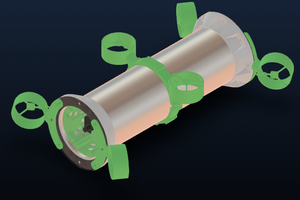Disclaimer: I wasn't originally going to bother posting this idea, but was convinced to by the recent blog post "We Have a Problem: Food Production". I'm not sure there is enough original innovation in this to warrant a prize, however I wanted to get the idea out there in case it inspires someone else with an even better idea. All I'm doing here is aggregating and leveraging other's innovations.
Background:
There are two related trends I have observed that I think warrant investigation.
1. As the recent blog post noted, the last century saw massive improvements in food production capacity thanks to technological innovation, saving billions of lives in the developing world. An emerging criticism of this Green Revolution is reports of decreased nutritional value in high yield crops. See: http://en.wikipedia.org/wiki/Green_Revolution :Criticism / Quality of Diet
http://www.scientificamerican.com/article/soil-depletion-and-nutrition-loss/
2. Somewhat more recently, market forces have shifted to make "organic" food wildly popular. This can be seen in the rise of local farmer's markets nationwide. For more purely anecdotal evidence, look at the stock price of "Whole Foods Markets" compared to the Dow since 1992.
An interesting twist to this is confusion over the term "organic", and a general (though unproven) perception of increased nutritional value. "A recent study examined the past 50 years' worth of scientific articles about the nutrient content of organic and conventional foods. The researchers concluded that organically and conventionally produced foodstuffs are not significantly different in their nutrient content."
The Problem:
Significant market forces and scientific research have indicated a profound need for more nutritious crops. The relatively bland labels of "organic" and the even more dubious "natural" have been insufficient at driving innovation towards this end. Further, it seems that while increasing in popularity, the benefits of buying "organic" seem to be largely subjective for the average shopper. Either they are philosophically pre-disposed to buying organic and are thus willing to pay the higher price, or they aren't.
A Partial Solution:
Two years ago, I had an idea for a solution. In a free market economy it is generally true that the cheapest product will win out. Where more expensive products can compete of course is in quality. A product will survive or thrive if it can offer a benefit in quality that outweighs its added cost. While this added benefit can of course be subjective, the effect is more pronounced if it can be easily measured and quantified for the customers. Most of you I'm sure remember the "Megahertz War" of the 1990s, and later the "Megapixels War" in digital cameras. From these two prominent examples, I realized that massive market forces can be captured if a particular aspect of quality can be quantified and compared to competitors.
My solution then is to provide a method of measuring and quantifying the nutritional content of crops. The success of Whole Foods and farmers markets proves that people are willing to pay more for food that is merely 'perceived' to be healthier. How much more will they pay for food that is proven to be healthier? A local farmer who can grow apples twice as nutrient rich as the supermarket's apples, and who can prove it to his customers in an easily quantifiable way, would have a huge competitive advantage.
Currently, crops compete largely on cost and aesthetic appeal. Thus markets have driven the cultivation of cheap, large, shiny, bright red apples because they "look" better on a store shelf. This has apparently resulted in a massive decline in the true nutritional content of food crops. If however crops competed based on nutritional content, market forces would drive innovation to instead focus on the cultivation of nutrient dense foods.
In summary: I do not know...
Read more »

 Jeffrey Phoon
Jeffrey Phoon
 Anteneh Gashaw
Anteneh Gashaw
 Abomination named Alex
Abomination named Alex
 Peter Walsh
Peter Walsh
Hi Keegan Reilly,
1. i am i am happy that you are aggreagting together the ideas, needs, projects that can fight the present day problems associated with food.... As you know already fl@C@ has put a good effort and realized a practical raman spectrometer. I love such projects that can bring the balance.
i am from india, and i have suffered from Green Revolution. We suffer here with malnutrition. Traditional foods had great deal of nutritional value, which was replaced with food that has more carbohydrates and fat and few less nutrition.
I think that spectrophotometer projects like spectruino, publiclabs - open spectrophotometer, & Raman pi, Ocean optics STS development kit, hamammatsu's microspectrometer, texas instruments dlp based spectrometer and fraunhofers' moems based spectrometer can equip everybody with a personal health and nutrition inspection system.
My work is also associated with spectrophotometer, and have created a spectrometer from scratch, but which is bulky, and with heavy heavy cost burden. That's when i found all these above projects and following all of them till date.
Apart from that beware about sham companies like tellspec which kind of cheats and changes and never finished what they promised. My posts over there are even deleted for criticizing their datas.... !
2. Spectrometers are one wide range of instrument right from space exploration right under chemical analysis in our food. I am in an effort to catalogue nutritional chart for traditional food, and it would be good if every body does that. I have also catalogued factory food based on E number and correlating them with spectral data.
3. here almost permaculture, biodynamic, and organic farming is taking back in practice now. we also could spectrometers, for soil, water and environmental assessment in a distributed way without the need for government or private testing laboratories (with free(dom) and cost effective devices like the above).
your knowledge about market economy are true and good. you know you are one of few groups of people thinking about symbiosis and ecology with economy with engineering knowledge. Great.
However my wishes for your effort. Go on.